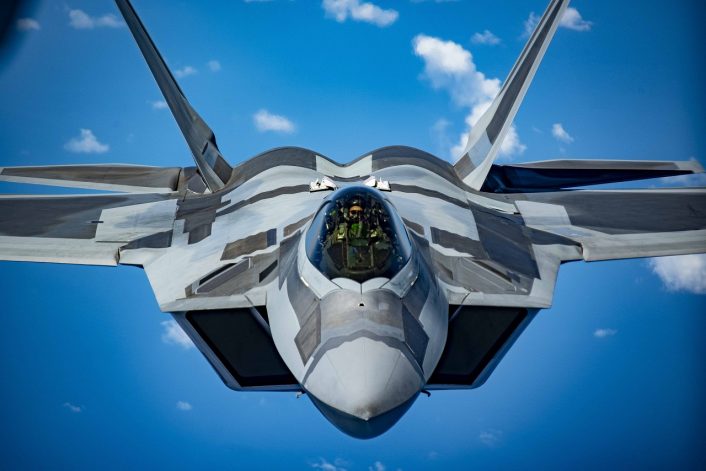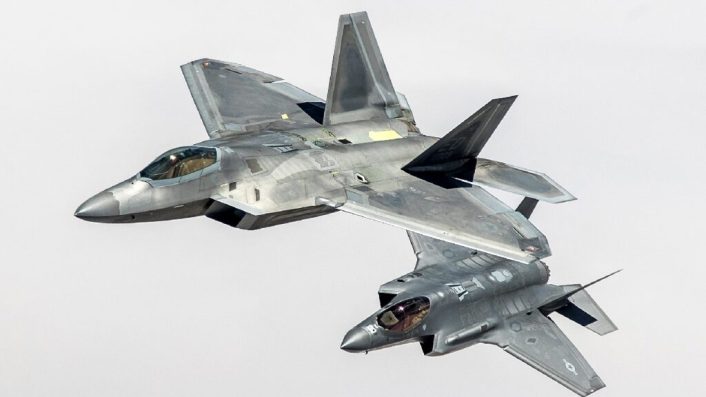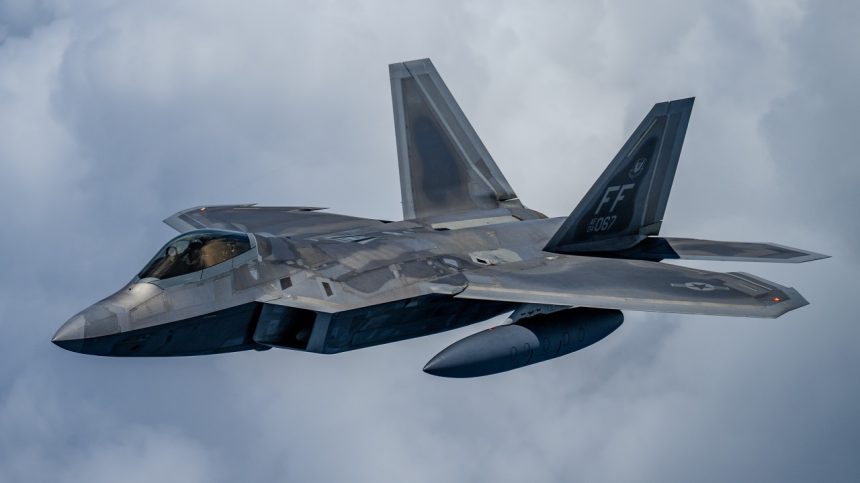The F-22 recently tested multiple new sensors as part of the modernization, with plans for a rapid prototyping effort to field them and expand the capabilities of the jet.
The U.S. Air Force is testing multiple new advanced sensors on the F-22 Raptor, which could extend its service life and also be applied to systems of the Next Generation Air Dominance family. The info was disclosed during the Life Cycle Industry Days conference.
“The F-22 team is working really hard on executing a modernization roadmap to field advanced sensors, connectivity, weapons, and other capabilities,” said Brig. Gen. Jason D. Voorheis, Program Executive Officer for Fighters and Advanced Aircraft. “The Raptor team recently conducted six flight test efforts to demo advanced sensors.”
Voorheis also added that the service is planning for a rapid prototyping effort to get these sensors fielded quickly. “We’re executing that successfully, and that will lead to […] a rapid fielding in the near future,” he said.
The news was first reported by Air and Space Forces Magazine, which also added that Air Force officials have also confirmed that the stealthy pods seen since last year being tested on the F-22 are indeed InfraRed Search and Track (IRST) sensors. The development of a new IRST sensor for the Raptor was also confirmed by the service’s budget document, however they did not mention the sensor being podded.
The sensors are part of an upgrade program worth $ 7.8 billion before 2030, of which $ 3.1 billion are for research and development and the remaining $ 4.7 billion are for procurement. This is in contrast with previous statements that the Air Force was looking to retire the F-22 around 2030.
“From an F-22 sunsetting perspective, I don’t have a date for you,” said Voorheis when asked about the topic. “What I can tell you is that we are hyper-focused on modernization to sustain that air superiority combat capability for a highly contested environment for as long as necessary.”
This also reflects recent comments by Gen. Kenneth Wilsbach, head of Air Combat Command, who mentioned that the service should retain also the older F-22s in the Block 20 configuration, together with the latest ones. The General added that several upgrades are being planned and even the older Block 20s are still very capable, should they be needed for combat in an emergency.

Voorheis also mentioned a software being integrated on the Raptor, which he defined as Government Reference Architecture Compute Environment, or “GRACE.” He further explained this open architecture software would allow “non-traditional F-22 software” to be installed on the aircraft and provide “additional processing and pilot interfaces.”
It’s unclear if the new GRACE is related to Project FOX, the innovation project tested last year which allowed to integrate on the F-35 software applications developed for the F-22. This allowed both 5th gen fighters to fly with common tactical software applications.
The F-22 upgrades
Some of the upgrades expected for the F-22 Raptor were unveiled in the Fiscal Year 23 budget request documentation and in an official artwork shared by Gen. Mark Kelly, then Commander of Air Combat Command. In the artwork we can see three Raptors loaded with new stealthy external fuel tanks, two underwing faceted pods and a new unknown air-to-air missile, but there are even more novelties in the documents, which unveils a previously undisclosed relationship between the F-22 and the development of the Next Generation Air Dominance (NGAD).
Two years after the upgrades were announced, we might have gotten, earlier this year, the first glimpse of the new stealthy external fuel tanks being developed for the F-22 Raptor. The aircraft was, in fact, spotted near the Mojave Air and Space Port and shows the Raptor with two fuel tanks, whose shape is reminiscent of the one shown in 2022.
The new tanks are officially known as Low Drag Tank and Pylon (LDTP) and designed to be stealthier and more aerodynamically efficient than the current 600-gallon fuel tanks. In the FY2023 budget request, the Air Force mentioned that the F-22 LDTPs are advanced technological designs providing increased persistence and range while maintaining lethality and survivability, critical to future mission execution and to maintaining Air Superiority.

The low drag tanks are intended to reduce drag, facilitate supersonic flight with external tanks and extend the range of the F-22. The pylons are equipped with smart rack pneumatic technology to accurately control ejection performance and smooth wind swept surface for minimum drag without stores.
The two pods installed under the outer underwing hardpoints have already been spotted during flight testing on an F-22 at the Air Force’s Plant 42 facility in Palmdale, California, in February 2022. The latest budget documents mention an InfraRed Search and Track (IRST) sensor being developed for the F-22, which is now confirmed to be the sensor housed inside the two pods, although they could host also other capabilities in addition to the IRST.
In July 2024 we got an up-close look at one of the pods installed under a Rockwell Sabreliner 65 testbed after a test campaign at Nellis AFB, Nevada. It would have been expected to see some kind of transparent surface associated with the IRST, however the surfaces on the nose of the pod appeared to be opaque. We still cannot exclude that there are two different variants of the pod, depending on the equipment inside.
The last upgrade featured in the artwork is a new unknown air-to-air missile. While there are a number of air-to-air missile programs in the works, it is possible that the one in the image could be a representative design, which may or may not correspond to the real deal, for the highly secretive AIM-260 missile. So far, the missile has never been depicted in any kind of image and details about the program are very scarce.
The development of the AIM-260, also called Joint Advanced Tactical Missile, was first unveiled in 2019 and has been in the works at least since 2017. The goal of the new long-range air-to-air missile is to replace the AIM-120 AMRAAM (Advanced Medium Range Air-to-Air Missile) and counter the threat posed by the Chinese PL-15 missile, while avoiding any foreign threats being able to outrange the AIM-120.
Among the few known technical details, the new missile will be compatible with the AMRAAM dimensions, but obviously with greater range, and is planned to be carried in the F-22 weapons bay and on the F/A-18 at first, with the F-35 to follow. Flight tests are already in progress and the missile is expected to be fielded by next year. Because of these reasons, it would be reasonable to suppose that the one shown in the image could be at least a hint at the AIM-260.
Other upgrades mentioned in the budget request are a Mode 5 Identification Friend or Foe (IFF), Link 16 and Multifunction Information Distribution System Joint Tactical Radio System (MIDS JTRS), a new Operational Fight Program, advanced radar Electronic Protection, Embedded GPS/Inertial Navigation System (INS) Modernization (EGI-M), Open System Architecture (OSA), new encrypted radios.

A new helmet is also being tested by F-22 pilots, as part of the Next Generation Fixed Wing Helmet program to replace the current HGU-55P helmet, which has been the standard issued helmet for the last 40 years. The goal is to provide pilots a more comfortable, stable, and balanced platform to accommodate helmet-mounted devices usage without imposing neck strain and discomfort to the user.
Despite various integration efforts in the past, the F-22 is not equipped yet with a helmet that provides the essential flight and weapon aiming information through line of sight imagery: the shape of the Raptor’s canopy, optimized to preserve Low Observability, doesn’t allow enough range of motion and minimum visibility to a pilot wearing the JHMCS or the Scorpion.









